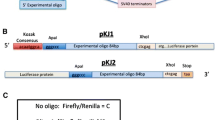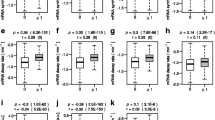Abstract
A multitude of factors contribute to the regulation of gene expression in living cells. The relationship between codon usage bias and gene expression has been extensively studied, and it has been shown that codon bias may have adaptive significance in many unicellular and multicellular organisms. Given the central role of mRNA in post-transcriptional regulation, we hypothesize that mRNA stability is another important factor associated either with positive or negative regulation of gene expression. We have conducted genome-wide studies of the association between gene expression (measured as transcript abundance in public EST databases), mRNA stability, codon bias, GC content, and gene length in Drosophila melanogaster. To remove potential bias of gene length inherently present in EST libraries, gene expression is measured as normalized transcript abundance. It is demonstrated that codon bias and GC content in second codon position are positively associated with transcript abundance. Gene length is negatively associated with transcript abundance. The stability of thermodynamically predicted mRNA secondary structures is not associated with transcript abundance, but there is a negative correlation between mRNA stability and codon bias. This finding does not support the hypothesis that codon bias has evolved as an indirect consequence of selection favoring thermodynamically stable mRNA molecules.
Similar content being viewed by others
References
Akashi H (1994) Synonymous codon usage in Drosophila melanogaster natural selection and translational accuracy. Genetics 136:927–935
Akashi H (1997) Codon bias evolution in Drosophila. Population genetics of mutation? selection drift, Gene 205:269-278
Akashi H (2001) Gene expression and molecular evolution. Curr Opin Genet Dev 11:660–666
Akashi H (2003) Translational selection and yeast proteome evolution, Genetics 164:1291–1303
Akashi H, Eyre- Walker A (1998) Translational selection and molecular evolution. Curr Opin Genet Dev 8:688–693
Akashi H, Gojobori T (2002) Metabolic efficiency and amino acid composition in the proteomes of Escherichia coli and Bachilus subtilis, Proc Natl Acad Sci USA 99:3696–3700
Altschul SF, Gish W, Miller W, Myers EW, Lipman DJ (1990) Basic local alignment search tool, J Mol Biol 215:403–410
Andersson SGE, Kurland CG (1990) Codon preferences in free-living microorganisms, Microbiol Rev 54:198–210
Antezana MA, Kreitman M (1999) The nonrandom location of synonymous codons suggests that reading frame-independent forces have patterned codon preferences. J Mol Evol 49:36–43
Bernardi G, Olofsson B, Filipski J, Zerial M, Salinas J, Cuny G, Meunier-Rotival M, Rodier F (1985) The mosaic genome of warm-blooded vertebrates, Science 228;953–958
Boguski MS, Lowe TM, Tolstoshev CM (1993) dbEST: database for “expressed sequence tags.” Nat Genet 4:332–333
Bose S, Dutko JA, Zitomer RS (2005) Genetic factors that regulate the attenuation of the general stress response of yeast. Genetics 169:1215–1226
Brown TA (1999) Genomes, John Wiley & Sons, New York
Bulmer M (1991) The selection-mutation-drift theory of synonymous codon usage, Genetics 129:897–907
Carlini DB, Chen Y, Stephan W (2001) The relationship between third-codon position nucleotide content, codon bias, mRNA secondary structure and gene expression in the drosophilid alcohol dehydrogenase genes Adh and Adhr. Genetics 159:623–633
Chiapello H, Fisacek F, Caboche M, Henaut A (1998) Codon usage and gene function are related in sequences of Arabidopsis thaliana. Gene 209:GC1–GC38
Coghlan A, Wolfe KH (2000) Relationship of codon bias to mRNA concentration and protein length in Saccharomyces cerevisiae, Yeast 16:1131–1145
Comeron JM (2004) Selective and mutational patterns associated with gene expression in humans: influences on synonymous composition and introns presence. Genetics 167:1293–1304
Comeron JM, Kreitman M (2002) Population, evolutionary and genomic consequences of interference selection. Genetics 161:389–410
Comeron JM, Kreitman M, Aguadé M (1999) Natural selection on synonymous sites is correlated with gene length and recombination in Drosophila. Genetics 151:239–249
Craig EA (1986) The heat shock response, CRC Crit Rev Biochem 18:239–280
Doshi KJ, Cannone JJ, Cobaugh CW, Gutell RR (2004) Evaluation of the suitability of free-energy minimization using nearest-neighbor energy parameters for RNA secondary structure prediction. BMC Bioinformatics 5:105
Duan J, Antezana MA (2003) Mammalian mutation pressure, synonymous codon choice, and mRNA degradation, J Mol Evol 57:694–701
Duret L (2000) tRNA gene number and codon usage in the C. elegans genome are co-adapted for optimal translation of highly expressed genes. Trends Genet 16:287–289
Duret L, Mouchiroud D (1999) Expression pattern and, surprisingly, gene length shape codon usage in Caenorhabditis, Drosophila, and Arabidopsti. Proc Natl Acad Sci USA 96;4482–4487
Fennoy SL, Bailey-Serres J (1993) Synonymous codon usage in Zea mays L. nuclear genes is varied by levels of C and G-ending codons, Nucleic Acids Res 21:5294–5300
Francino HP, Ochman H (1999) Isochores result from mutation not selection. Nature 400:30–31
Gentles AJ, Karlin S (2001) Genome-scale compositional comparisons in eukaryotes. Genome Res 11:540–546
Gouy M, Gautier C (1982) Codon usage in bacteria: correlation with gene expressivity. Nucleic Acids Res 10:7055–7074
Gouy M, Gautier C, Attimonelli M, Lanave C, di Paola G (1985) ACNUC: portable retrieval system for nucleic acid sequence databases: logical and physical designs and usage. Comput Appl Biosci 1:167–172
Grunberg-Manago M (1999) Messenger RNA stability and its role in control of gene expression in bacteria and phages, Annu Rev Genet 33:193–227
Guhaniyogi J, Brewer G (2001) Regulation of mRNA stability in mammalian cells, Gene 265:11–23
Hey J, Kliman RM (2002) Interactions between natural selection, recombination and gene density in the genes of Drosophila, Genetics 160:595–608
Hofacker IL, Fontana W, Stadler PF, Bonhoeffer LS, Tacker M, Schuster P (1994) Fast folding and comparison of RNA secondary structures, Monatsh Chem 125:167–188
Iida K, Akashi H (2000) A test of translational selection at ‘silent’ sites in the human genome: base composition comparisons in alternatively spliced genes, Gene 261:93–105
Ikemura T (1981a) Correlation between the abundance of Escherichia coli transfer RNAs and the occurrence of the respective codons in its protein genes. J Mol Biol 146:1–21
Ikemura T (1981b) Correlation between the abundance of Escherichia coli transfer RNAs and the occurrence of the respective codons in its protein genes: a proposal for a synonymous codon choice that is optimal for the E. coli system, J Mol Biol 151:389–409
Ikemura T (1985) Codon usage and tRNA content in unicellular and multicellular organisms, Mol Biol Evol 2:13–34
Jenkins GM, Holmes EC (2003) The extent of codon usage bias in human RNA viruses and its evolutionary origin, Virus Res 92:1–7
Kanaya S, Yamada Y, Kudo Y, Ikemura T (1999) Studies of codon usage and tRNA genes of 18 unicellular organisms and quantification of Bacillus subtilis tRNAs; gene expression level and species-specific diversity of codon usage based on multivariate analysis, Gene 238:143–155
Kanaya S, Yamada Y, Kinouchi M, Kudo Y, Ikemura T (2001) Codon usage and tRNA genes in eukaryotes; correlation of codon usage diversity with translation efficiency and with CG-dinucleotide usage as assessed by multivariate analysis, J Mol Evol 53:290–298
Karlin S, Campbell AM, Mrazek J (1998) Comparative DNA analysis across diverse genomes, Annu Rev Genet 32:185–225
Katz L, Burge CB (2003) Widespread selection for local RNA secondary structure in coding regions of bacterial genes. Genome Res 13:2042–2051
Kliman RM, Hey J (1993) Reduced natural selection associated with low recombination in Drosophila melanogaster. Mol Biol Evol 10:1239–1258
Kliman RM, Hey J (1994) The effects of mutation and natural selection on codon bias in the genes of Drosophila, Genetics 137:1049–1056
Konings DA, Gutell RR (1995) A comparison of thermodynamic foldings with comparatively derived structures of 16S and 16S-like rRNAs. RNA 1:559–574
Li WH (1987) Models of nearly neutral mutations with particular implications for nonrandom usage of synonymous codons, J Mol Evol 24:337–345
Marais G, Duret L (2001) Synonymous codon usage, accuracy of translation, and gene length in Caenorhabditis elegans, J Mol Evol 52:275–280
Margulies EH, Kardia SL, Innis JW (2001) Identification and prevention of a GC content bias in SAGE libraries, Nucleic Acids Res 29:E60
Mathews DH, Sabina J, Zuker M, Turner DH (1999) Expanded sequence dependence of thermodynamic parameters improves prediction of RNA secondary structure, J Mol Biol 288:911–940
Meister G, Tuschl T (2004) Mechanisms of gene silencing by double-stranded RNA, Nature 431:343–349
Miyasaka H (2002) Translation initiation AUG context varies with codon usage bias and gene length in Drosophila melanogaster, J Mol Evol 55:52–64
Morita MT, Kanemori M, Yanagi H, Yura T (2000) Dynamic interplay between antagonistic pathways controlling for the σ32 level in Escherichia coli, Proc Natl Acad Sci USA 97:5860–5865
Moriyama EN, Powell JR (1997) Codon usage bias and tRNA abundance in Drosophila. J Mol Evol 45:514–523
Mount DW (2001) Bioinformatics: sequence and genome analysis, Cold Spring Harbor Laboratory Press, Cold Spring Harbor, New York
Munoz ET, Bogarad LD, Deem MW (2004) Microarray and EST database estimates of mRNA expression levels differ; the protein length versus expression curve for C. elegans. BMC Genomics 5:30
Musto H, Cruveiller S, D’Onofrio G, Romero H, Bernardi G (2001) Translational selection on codon usage in Xenopus laevis. Mol Biol Evol 18:1703–1707
Norusis MJ (2000) SPSS 10.0 guide to data analysis, Prentice Hall, NJ
Pervouchine DD, Graber JH, Kasif S (2003) On the normalization of RNA equilibrium free energy to the length of the sequence, Nucleic Acids Res 31:e49
Rice P, Longden I, Bleasby A (2000) EMBOSS: the European Molecular Biology Open Software Suite. Trends Genet 16:276–277
Rozas J, Rozas R (1999) DnaSP version 3: an integrated program for molecular population genetics and molecular evolution analysis, Bioinformatics 15:174–175
Sharp PM, Lloyd AT (1993) Codon usage. In Maroni GP (ed) Atlas of Drosophila genes. Oxford University Press, New York, pp. 378–397
Sharp PM, Matassi G (1994) Codon usage and genome evolution, Curr Opin Genet Dev 4:851–860
Sharp PM, Stenico M, Peden JF, Lloyd AT (1993) Codon usage; mutational bias, translational selection, or both? Biochem Soc Trans 21:835–841
Sharp PM, Averof M, Lloyd AT, Matassi G, Peden JF (1995) DNA sequence evolution: the sounds of silence, Phi Trans R Soc London B 349:241–247
Shields DC, Sharp PM, Higgins DG, Wright F (1988) “Silent” sites in Drosophila genes are not neutral: evidence of selection among synonymous codons. Mol Biol Evol 5:704–716
Stenico M, Lloyd AT, Sharp PM (1994) Codon usage in Caenorhabditis elegans: delineation of translational selection and mutational bias, Nucleic Acids Res 22:2437–2446
Stenøien HK (2005) Adaptive basis of codon usage in the haploid moss Physcomitrella patens, Heredity 94:87–93
Tinoco I, Bustamante C (1999) How RNA folds. J Mol Biol 293:271–281
Tuite MF (1996) RNA processing: death by decapitation for mRNA, Nature 382:577–579
Walter AE, Turner DH, Kim J, Lyttle MH, Muller P, Mathews DH, Zuker M (1994) Coaxial stacking of helixes enhances binding of oligonucleotides and improves predictions of RNA folding. Proc Natl Acad Sci USA 91:9218–9222
Wolfe K, Sharp PM, Li WH (1989) Mutation rates differ among regions of the mammalian genome, Nature 337:283–285
Zuker M, Mathews DH, Turner DH (1999) Algorithms and thermodynamics for RNA secondary structure prediction: a practical guide. In Barciszewski J, Clark BFC (eds) RNA biochemistry and biotechnology, NATO ASI Series, Kluwer Academic Publishers, pp. 11–43
Acknowledgments
We thank John Parsch, Martin Kreitman, and anonymous reviewers for helpful comments. This work has been partly supported by the Norwegian Research Council grant no. 134800/410, and partly by the Swedish Research Council grant no. 621-2002-5896.
Author information
Authors and Affiliations
Corresponding author
Additional information
[Reviewing Editor: Dr. Martin Kreitman]
Rights and permissions
About this article
Cite this article
Stenøien, H.K., Stephan, W. Global mRNA Stability Is Not Associated with Levels of Gene Expression in Drosophila melanogaster But Shows a Negative Correlation with Codon Bias. J Mol Evol 61, 306–314 (2005). https://doi.org/10.1007/s00239-004-0271-9
Received:
Accepted:
Published:
Issue Date:
DOI: https://doi.org/10.1007/s00239-004-0271-9




